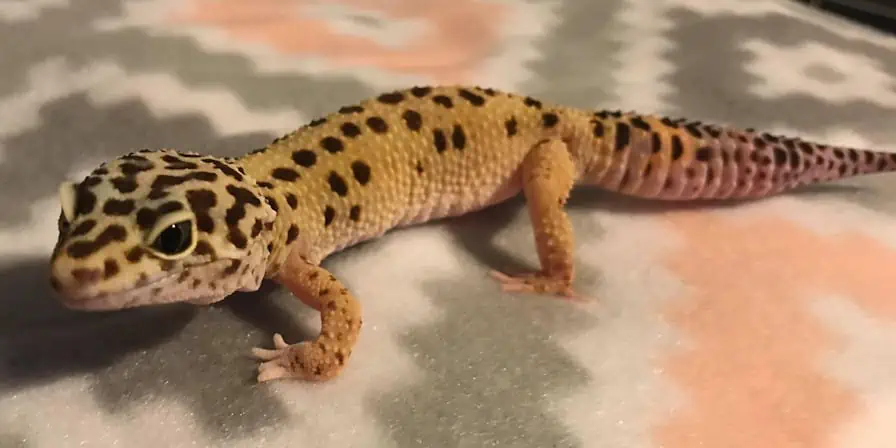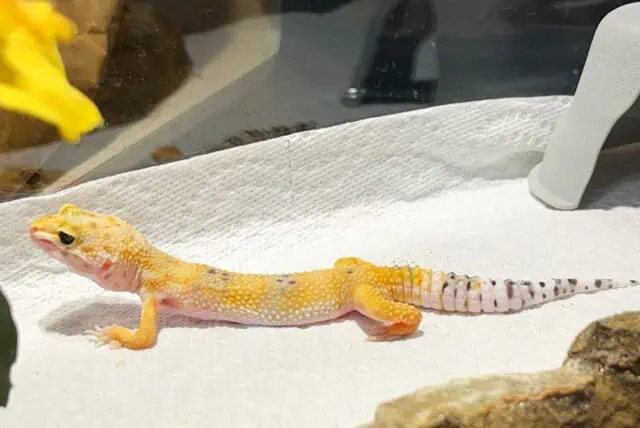Metabolic bone disease (MBD) is a prevalent and concerning ailment that impacts leopard geckos, often stemming from dietary imbalances or environmental mismanagement. In understanding MBD’s profound effect on these fascinating reptiles, it’s crucial to recognize the symptoms, causes, and treatments to ensure their longevity and health.
What is Metabolic Bone Disease?
Metabolic Bone Disease, commonly referred to as MBD, is a collective term for various conditions that lead to the weakening and deforming of a reptile’s bones. This ailment is often attributed to nutritional imbalances or other external factors, predominantly seen in captive reptiles like leopard geckos.
How Does it Affect Leopard Geckos?
Metabolic bone disease has a profound impact on the overall health and well-being of leopard geckos. When a leopard gecko is afflicted with MBD, its vitality and vigor are drastically diminished, making it more susceptible to other illnesses and reducing its lifespan.
Common symptoms of MBD in leopard geckos are varied and can be heartbreaking to witness. One of the most evident symptoms is the “rubber jaw syndrome.”
In this condition, the gecko’s jaw becomes soft and malleable, hindering its ability to eat and causing noticeable deformities. It may cause an underbite, for example.
Another alarming sign is the occurrence of broken bones. Due to the weakening of their skeletal structure from MBD, even minor falls or mishandling can result in fractures.
Additionally, many leopard geckos with metabolic bone disease exhibit lethargy or a noticeable loss of mobility. They become less active, often staying in one spot for extended periods, and their usual enthusiastic movements are replaced with a lethargic drag.
Several factors can lead to MBD in leopard geckos. A significant cause is an unbalanced diet that lacks essential nutrients, primarily calcium.
Inadequate exposure to UVB lighting or natural sunlight hampers the gecko’s ability to produce Vitamin D3, crucial for calcium absorption.
Poor husbandry practices, like an inappropriate environment or inconsistent care routines, can also be culprits behind the onset of this disease in leopard geckos.
Causes of Metabolic Bone Disease in Leopard Geckos
Identifying the root causes of metabolic bone disease in leopard geckos is essential for prevention and treatment. Several factors, ranging from dietary choices to environmental conditions, play pivotal roles in the onset of this ailment.
Loss of Appetite
A discernible loss of appetite is a prevalent symptom observed in leopard geckos suffering from metabolic bone disease. This decline in their feeding enthusiasm isn’t merely a fickle change in preference.
Pain, stemming from jaw issues associated with the disease, can make the act of eating agonizing for these reptiles. Moreover, the general weakness induced by MBD further deters them from their regular feeding routines, amplifying their discomfort.
The implications of a persistent loss of appetite in leopard geckos are grave. When a gecko doesn’t consume enough nutrients, it can become malnourished, leading to a weakened immune system.
This makes them more susceptible to infections, diseases, and other health problems. Additionally, weight loss, dehydration, and a decreased ability to heal from injuries or fight off parasites can stem from prolonged feeding neglect.
Unbalanced Diet
Leopard geckos, like all living creatures, thrive best when nourished with a well-rounded diet tailored to their specific needs. For these unique reptiles, an unbalanced diet can spell disaster, especially when it comes to their bone health.
The inclusion of calcium-rich foods is paramount for them. Insects like crickets, mealworms, and dubia roaches, when dusted with a calcium supplement, become nutrient powerhouses that bolster the gecko’s skeletal framework.
However, merely understanding the importance of calcium isn’t enough. It’s a delicate balance; both calcium deficiency and excessive calcium levels bring their own set of challenges.
A deficiency can weaken their bones, making them prone to fractures and other ailments. Conversely, too much calcium can lead to other health complications, including calcification of organs.
A noteworthy player in this calcium balance is vitamin D3. This vitamin aids in the metabolism and absorption of calcium in the gecko’s body.
Without adequate levels of vitamin D3, even a calcium-rich diet can fall short in providing the necessary nutrients. Supplementation often becomes vital in ensuring that leopard geckos get the right amount of both calcium and vitamin D3.
Inadequate Exposure to UVB Lighting or Natural Sunlight
Sunlight isn’t just for suntans and solar panels; it plays a vital role in the health and well-being of leopard geckos. Specifically, UVB lighting or natural sunlight stands as a formidable guard against metabolic bone disease in these creatures.
UVB rays are like magic wands, allowing geckos to produce the crucial vitamin D3. This isn’t a vitamin to scoff at; it’s responsible for aiding the absorption of calcium, ensuring bones stay strong and resilient.
For those housing their leopard geckos indoors, it’s essential to simulate their natural environment. The recommended UVB lighting output for these reptiles falls between 5-7% UVI, with a consistent exposure duration of 12-14 hours each day. It mimics their natural habitat, ensuring they get the rays they need to remain healthy.
However, what about geckos that, for some reason, can’t bask in this simulated sunlight? Here’s where modern pet care shines. Multivitamins containing both calcium and vitamin D3 serve as fantastic alternatives. They ensure that even without optimal UVB exposure, geckos still receive the vital nutrients they need.
Nevertheless, it’s always a good practice for keepers to ensure UVB lighting is a primary source, with multivitamins acting as supportive backup, guaranteeing their scaled friends lead robust, healthy lives.
Poor Husbandry Practices
When we talk about the well-being of leopard geckos, one of the most prominent contributors to issues like metabolic bone disease is poor husbandry practices. Providing an inappropriate environment or diet can drastically affect the health of these reptiles.
Husbandry is more than just shelter and food; it’s about creating an environment that closely mimics their natural habitat and offering a balanced, nutritional diet.
Improper temperatures, humidity levels, or unclean enclosures can stress the gecko, compromising its immune system and overall health.
Neglecting the dietary needs of the gecko, such as failing to provide calcium-rich foods or necessary supplements, can directly lead to metabolic bone disease.
A lack of regular health checks and ignoring early signs of distress can exacerbate any underlying issues. It can be something that impacts its health minimally, but it could also be something like Cryptosporidiosis. In essence, a leopard gecko’s health, like all pets, is highly dependent on the care it receives.
Calcium Deficiency/Low Calcium Levels
Calcium plays an integral role in the skeletal health of leopard geckos. A deficiency or low levels of calcium can lead to significant health problems for these reptiles. When a gecko is deprived of adequate calcium, it experiences weakened bones, making them more susceptible to fractures and breaks.
Decalcification, a process where the bones lose their calcium content, can also occur, causing them to become soft and pliable. This is especially evident in symptoms like the rubber jaw syndrome, where the gecko’s jaw loses its firmness.
Both calcium and vitamin D3 work hand in hand in maintaining bone health. While calcium is essential for building and maintaining strong bones, vitamin D3 aids in the absorption of this vital mineral.
Thus, preventing metabolic bone disease in leopard geckos requires a twofold approach. It’s crucial to ensure that their diet contains calcium-rich foods, and supplementing their meals with calcium and vitamin D3 powders is often recommended.
Providing UVB lighting, which aids in vitamin D3 synthesis, ensures that the ingested calcium is effectively absorbed and utilized.
High Phosphorus Ratio
The balance between calcium and phosphorus is pivotal in the calcium metabolism of leopard geckos. A high phosphorus ratio in their diet can disrupt this balance and significantly contribute to the development of metabolic bone disease.
Excessive phosphorus competes with calcium during absorption in the digestive tract, essentially inhibiting the uptake of calcium. As a result, the more phosphorus there is in the diet, the less calcium the gecko is able to absorb. This imbalance between the two minerals can lead to conditions like hyperphosphatemia, where the phosphorus levels in the blood become abnormally high.
Hyperphosphatemia, when combined with the reduced availability of calcium, can result in hypoparathyroidism in leopard geckos. This condition means there’s insufficient production of parathyroid hormone, which plays a critical role in regulating and maintaining the calcium-phosphorus balance in the blood.
Consequently, geckos with this imbalance can suffer from various health issues, including weakened bones, muscle tremors, and metabolic disturbances.
To ensure a healthy leopard gecko, it’s essential to maintain the optimal calcium-to-phosphorus dietary ratio. Experts recommend a 3:1 ratio, which means for every three parts of calcium, there should be one part of phosphorus.
Parathyroid Gland Malfunction
In leopard geckos, as in other vertebrates, the parathyroid glands play an indispensable role in regulating calcium levels in the body.
These tiny glands are responsible for the release of parathyroid hormone (PTH), which actively manages and maintains the delicate balance of calcium in the bloodstream. PTH functions by increasing calcium levels when they are too low, either by promoting the release of calcium from bones, increasing calcium absorption from the gut, or promoting calcium reabsorption from the kidneys.
However, when there’s a malfunction in the parathyroid glands, this critical balance can be disrupted, leading to aberrations in calcium metabolism. Such a malfunction can stem from various reasons, including genetic factors, injury, or disease.
Imbalances in calcium levels—whether too high or too low—can have detrimental effects on a leopard gecko’s health, as calcium is essential for various bodily functions, including muscle contraction, bone health, and nerve transmission.
Symptoms arising from parathyroid gland dysfunction in leopard geckos are diverse. Geckos might exhibit signs like tremors, muscle weakness, or spasms, given the crucial role of calcium in muscle function. In severe cases, disruptions in heart rhythm or bone deformities may occur.
Symptoms of Metabolic Bone Disease in Leopard Geckos
Metabolic Bone Disease (MBD) in leopard geckos is a complex ailment with a range of manifestations that can severely compromise the health and longevity of these beloved reptiles. As MBD progresses, it not only affects the structural integrity of their bones but also hampers their daily activities and overall well-being. Recognizing the early warning signs and symptoms is crucial for timely intervention and optimal care.
Rubber Jaw Syndrome
Rubber jaw syndrome in leopard geckos is a concerning manifestation of metabolic bone disease, directly impacting the structural integrity of their jaw bones. This condition is characterized by the softening of the jaw, making it feel malleable, almost like rubber, when touched.
As the disease progresses, jaw swelling becomes evident, along with receding and deformities that alter the gecko’s facial appearance. The swelling and changes to the jaw structure create significant challenges for the gecko, especially when it comes to feeding.
A deformed jaw can hinder their ability to effectively grasp and consume food, leading to reduced nutrient intake and exacerbating their health issues.
Broken Bones

Metabolic Bone Disease (MBD) in leopard geckos has a direct and detrimental effect on their skeletal health, often manifesting in the form of broken bones. Due to MBD, the bones of the affected gecko become weaker and lose their structural integrity. This bone weakness greatly increases the risk of fractures.
Among the different types of fractures that can occur, greenstick fractures are particularly concerning. Unlike clean breaks, greenstick fractures cause the affected bones to appear bent rather than fully broken. In lizards, this often translates to visibly bowed legs, an unmistakable sign of bone compromise.
Lethargy/Lack of Mobility
Lethargy and lack of mobility are telltale signs of metabolic bone disease in leopard geckos, especially in the early stages of the condition. Often linked to calcium deficiency, these symptoms manifest in geckos as a noticeable decrease in their usual lively behavior.
Affected geckos might appear unresponsive, showing little interest in their surroundings, food, or any stimuli. This inactivity stems from the discomfort and weakness caused by the disease, leading to a reluctance or even an inability to move.
Diagnosis and Treatment of Metabolic Bone Disease in Leopard Geckos
Detecting and managing metabolic bone disease in leopard geckos requires a thorough understanding of its indicators and the necessary interventions. Early detection is crucial for ensuring a positive outcome.
Regular reptile vet check-ups, especially if the owner notices any signs of illness or unusual behavior, play an essential role in early diagnosis. Full-body X-rays can be particularly revealing, highlighting any bone weakness or other skeletal abnormalities indicative of the disease.
Once diagnosed, a tailored treatment approach is necessary. Typically, this involves addressing the underlying cause, often related to dietary imbalances.
Calcium supplementation becomes paramount in replenishing depleted levels and restoring bone health. Similarly, vitamin D3 supplementation is critical, as it aids in the proper absorption of calcium.






